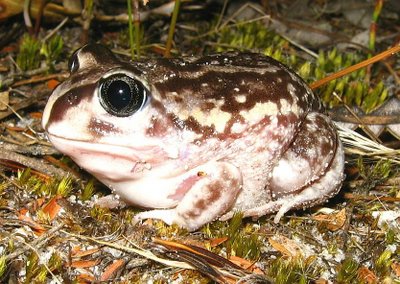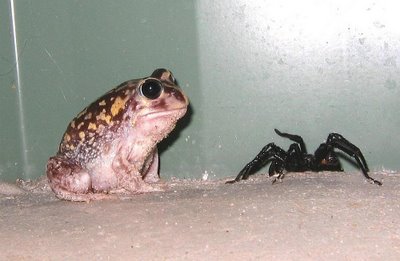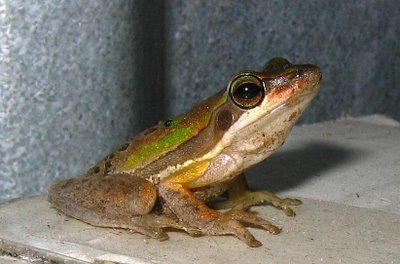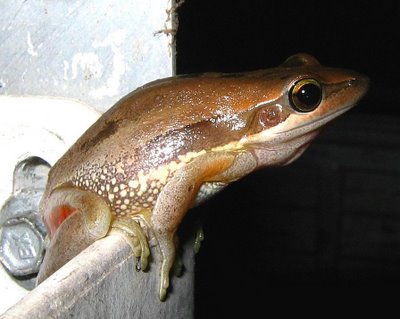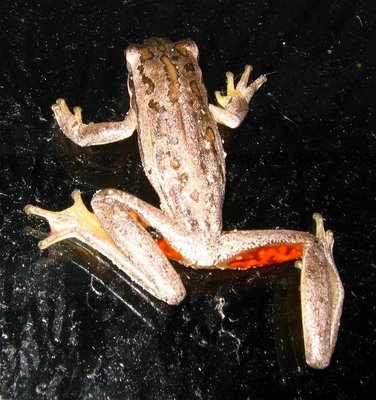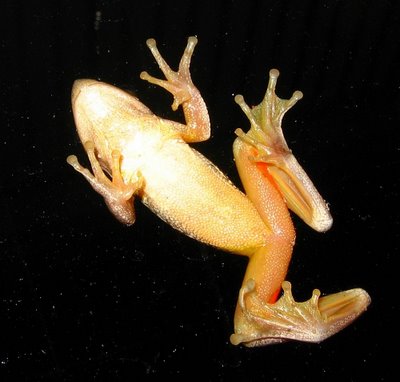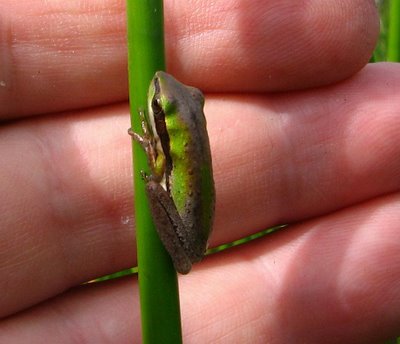The best known burrowing frog. Once heard, never forgotten.
It doesn't matter if you are tone deaf or even hard of hearing as the 'bonk' - 'bonk' banjo like call is difficult to confuse with anything else. And if in their territory you have reasonable pools of water, you will hear it just about every night. I even had one hopeful banjo frog who had found a sunken plastic container full of water for the birds, he bonked loudly for over three weeks trying to attract a lady to his little paradise. But it was to no avail, being over 100 metres from an actual swamp, the banjo ladies were not taken in by calls of love from a dry sandy area. Eventually the frog gave up and presumably joined the competition at the swamp.
So you hear the call and say to yourself, I know that - it’s a western banjo frog, so you go looking for it. Now your troubles really start as tracking the actual frog from their calls is no easy thing to do, and most times given up in frustration, even when you know it is within a metre or two. Most frogs are very well camouflaged and their calls deceptive, particularly relating to distance from you. This is often made even more difficult when several frogs are calling from the same area. Fortunately they are quite distinctive when seen, so I just go looking and usually find them when they are moving around.
Western Banjo Frog, Limnodynastes dorsalis

I often think of the banjo frog as a bandit, just take note the distinctive mask-like eye patch that is underlined by a glandular white stripe, next note the bulge (oval gland) on each thigh. Despite other marking variations, these features are common to all of these frogs. Also with most of these banjo frogs there is a strongly marked pale stripe running down their back and the groin is usually crimson. The above distinctive features make it difficult to confuse it with other species, particularly when it is also the only Limnodynastes species in southern WA.
A bandit-looking western banjo frog - also note the raised thigh glands

Frogs from the genus Limnodynastes occur in areas where water can collect in deepish pools and therefore tend to be more common in the higher rainfall regions of eastern and northern Australia. These frogs differ from other frogs by constructing floating rafts of foam, into which the eggs are laid and fertilised. Once the tadpoles hatch they fall through to the water below. In my district there is little permanent water, but due to the dominant winter rainfall, many ephemeral swamps usually fill with water to provide suitable breeding habitat. Although frogs will move from one swamp to another, they are seldom found far from these areas. During long hot dry periods they will dig a burrow and await the winter rains.
"I don't think he saw me"

The range of coloration and markings amongst frogs of the same species is often remarkable, even within a small area. I have written about this before in relation to the Slender Tree Frog, Litoria adelaidensis 07. Frog colouration where there was a distinct correlation between the frog markings/coloration and habitat. Interestingly, the same thing seems to occur with the Western Banjo Frog. In the all these photographs, please note not only the coloration of the frog, but the habitat background, they are remarkably similar. Probably the most extreme color variation of the banjo frog, but look at the sandy background

At the other extreme, these banjo frogs do not get much darker

The range of the Western Banjo Frog is just a little larger than the WA Wheatbelt zone, extending from the Murchison River (500 km north of Perth) to around 200 km east of Esperance. However there are other Banjo Frogs in Australia, so their call is known far and wide. The Eastern Banjo Frog, Limnodynastes dumerillii occurs from Adelaide to around Brisbane including most of Victoria and Tasmania. Then there is the Giant Banjo Frog, Limnodynastes interioris that inhabits central NSW and northern Victoria. And lastly the Northern Banjo Frog, Limnodynastes terraereginae that occurs from central NSW to the top of Cape York Peninsula. So if you like the sound of the banjo, there is plenty to keep you amused. Another name for this frog is Pobblebonk.
 Western Banjo Frog, Limnodynastes dorsalis
Western Banjo Frog, Limnodynastes dorsalis
Frogs are very reliant on suitable habitat and if that habitat is destroyed or altered, the frogs are often the first to suffer. Even if you have many frogs, if they are of the same species then you should be looking at providing greater diversity of habitat so other species can find a place too. Attracting frogs to your garden is much like attracting birds; it can be an absorbing hobby to see how many species you can accommodate. But it is important not to collect frogs from one area and introduce them to another, as a serious frog fungal disease can also be introduced by this means that can devastate frog populations and even kill entire species. So if you provide the habitat, they will move in of their own accord, where hopefully they can then build their numbers to spread to other suitable areas. This is a terrific way of being eco-friendly.
"Us frogs are really very friendly, plus we eat all the things you don't like"





















